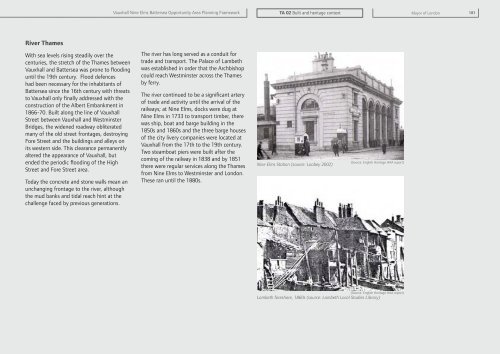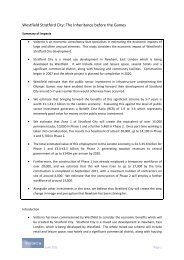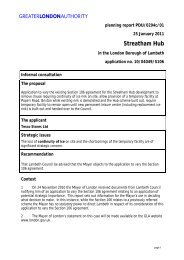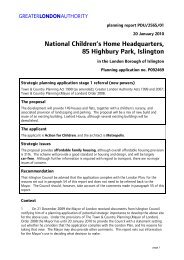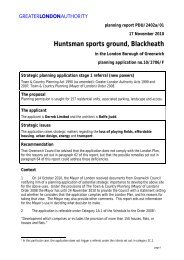Vauxhall Nine Elms Battersea Opportunity Area Planning Framework
Vauxhall Nine Elms Battersea Opportunity Area Planning Framework
Vauxhall Nine Elms Battersea Opportunity Area Planning Framework
You also want an ePaper? Increase the reach of your titles
YUMPU automatically turns print PDFs into web optimized ePapers that Google loves.
<strong>Vauxhall</strong> <strong>Nine</strong> <strong>Elms</strong> <strong>Battersea</strong> <strong>Opportunity</strong> <strong>Area</strong> <strong>Planning</strong> <strong>Framework</strong>TA 02 Built and heritage contextMayor of London 181River ThamesWith sea levels rising steadily over thecenturies, the stretch of the Thames between<strong>Vauxhall</strong> and <strong>Battersea</strong> was prone to floodinguntil the 19th century. Flood defenceshad been necessary for the inhabitants of<strong>Battersea</strong> since the 16th century with threatsto <strong>Vauxhall</strong> only finally addressed with theconstruction of the Albert Embankment in1866-70. Built along the line of <strong>Vauxhall</strong>Street between <strong>Vauxhall</strong> and WestminsterBridges, the widened roadway obliteratedmany of the old street frontages, destroyingFore Street and the buildings and alleys onits western side. This clearance permanentlyaltered the appearance of <strong>Vauxhall</strong>, butended the periodic flooding of the HighStreet and Fore Street area.Today the concrete and stone walls mean anunchanging frontage to the river, althoughthe mud banks and tidal reach hint at thechallenge faced by previous generations.The river has long served as a conduit fortrade and transport. The Palace of Lambethwas established in order that the Archbishopcould reach Westminster across the Thamesby ferry.The river continued to be a significant arteryof trade and activity until the arrival of therailways; at <strong>Nine</strong> <strong>Elms</strong>, docks were dug at<strong>Nine</strong> <strong>Elms</strong> in 1733 to transport timber, therewas ship, boat and barge building in the1850s and 1860s and the three barge housesof the city livery companies were located at<strong>Vauxhall</strong> from the 17th to the 19th century.Two steamboat piers were built after thecoming of the railway in 1838 and by 1851there were regular services along the Thamesfrom <strong>Nine</strong> <strong>Elms</strong> to Westminster and London.These ran until the 1880s.<strong>Nine</strong> <strong>Elms</strong> Station (source: Loobey 2002)(Source: English Heritage HAA report)(Source: English Heritage HAA report)Lambeth foreshore, 1860s (source: Lambeth Local Studies Library)


